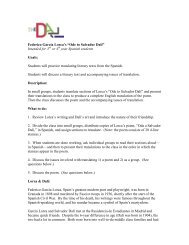Lesson Plan 2: Collage College In this lesson ... - The Dali Museum
Lesson Plan 2: Collage College In this lesson ... - The Dali Museum
Lesson Plan 2: Collage College In this lesson ... - The Dali Museum
You also want an ePaper? Increase the reach of your titles
YUMPU automatically turns print PDFs into web optimized ePapers that Google loves.
<strong>The</strong> Surrealists also liked collage because anyone can do it, and that meant more artists and more<br />
people thinking about why things go together the way they do—or why they don’t go together.<br />
Your teacher has brought in some old magazines and newspapers for you to cut up and make into<br />
collages of your own Surreal world. But before you begin, you’ll need to decide on a theme.<br />
Take a minute to write some notes for yourself on apiece of paper. Will your collage be<br />
psychological? Philosophical? Political? How about dreamlike? And remember, the Surrealists<br />
enjoyed using humor, so feel free to add in funny images. Keep in mind some of the techniques<br />
that help make something Surreal: juxtaposition, dislocation, and transformation.<br />
Now go through the magazines and find images which you think symbolize your idea. Carefully<br />
cut them out and arrange them on the poster board or paper that your teacher has brought in—but<br />
don’t glue the images down yet! Arrange and rearrange them until you find the proper balance,<br />
and when you do, then glue it all down.<br />
3. Writing & Reflection (<strong>In</strong>-class or for homework)<br />
Your teacher is about to turn your classroom into a museum—and your collage is going to be<br />
part of the exhibit! As you’ll find out when you tour the Salvador Dalí <strong>Museum</strong>, however, art<br />
museums are more than just art. Most paintings are accompanied by one or two paragraphs of<br />
writing that discuss the work at hand and teach the museum’s visitors about what they’re looking<br />
at. Since your collage is on display, spend some time writing a couple of paragraphs that<br />
describe your work. What images did you choose and why?<br />
Why did you arrange them the way you did, and did you have a message you wanted to get<br />
across? Were you trying to surprise or shock? Did you try to use juxtaposition, dislocation or<br />
transformation? Did you cut out images that you ended up not using? Try to be as precise as<br />
possible—what you did might seem perfectly clear to you, but you’re the artist! To someone else<br />
who doesn’t know you, your work could be a total mystery.<br />
Teachers! Try experimenting with <strong>this</strong> exercise to make it more complex and interesting for<br />
higher-level students. Have students bring in photos from home, or provide materials for mixedmedia<br />
collages and assemblages: cloth, buttons, sandpaper, nuts, bolts, other more threedimensional<br />
materials, written text and poems, and possibly even leftover materials from shop or<br />
other studio art projects. You can even encourage students to collage their collages with other<br />
student work—which could subsequently provide opportunities for collaborative writing in the<br />
“Writing & Reflection” segment of <strong>this</strong> <strong>lesson</strong>.



